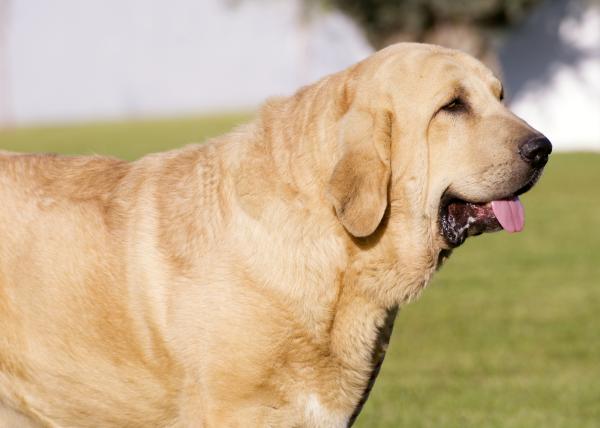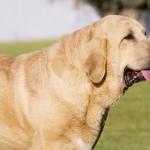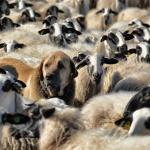Spanish Mastiff

In the most rural environments of the Spanish countryside we find the historical breed, the Spanish Mastiff. Considered the largest dog in Spain, they are known for their incredible physique. They're also known for their guarding skills. However, nowadays the Spanish Mastiff makes an excellent animal companion, even if we live in the city.
Therefore, whether you are considering adopting a dog of these characteristics or if you already live with one and want to expand your information, in this AnimalWised breed file we will elaborate on everything you need to know about the Spanish Mastiff.
- Europe
- Spain
- Group II
- 5-14
- 14-18
- 18-22
- 22-27
- 27-31
- More than 31
- 2-7
- 7-22
- 22-55
- 55-100
- 100-220
- 8-10
- 10-12
- 12-14
- 15-20
- Low
- Meidum
- High
Origin
Since ancient times, the Spanish Mastiff has been present in the farms and the rural lands of Spain. On one hand it is believed to come from the Celts and Phoenicians, but on the other hand it is also suspected to come from the Romans as combat dogs. Others, claim that they are descendants from the Assyrian or the Bulldogs. What is certain is that in 1273, the year of the foundation of the Mesta, the Mastiffs were carrying out grazing work in the Iberian Peninsula.
It is therefore a dog rooted in the Spanish agricultural tradition. It would be the main person in charge of taking care of the fields and protecting them from theft and interference. Moreover, even today they continue to fulfil the role as guardians in many fields. This is due to their protective character and their imposing physique. In fact, it would be strange to see a family farm with no Spanish Mastiff protecting it.
Not only did the Spanish Mastiff serve as guard dogs, but they also carried out the role of the German Shepard across the country. They would guide and defend the cattle against predators. Nowadays, due to the changes in livestock techniques, the Spanish Mastiff's main role is as a caretaker of land and a companion dog. Now it is becoming more common to see them out on walks with their companions in bigger cities.
Physical Appearance
Mastiffs are classified as a giant dog breed, which is more than justified as males can weigh up to 220 lbs. Females weigh between 110 lbs - 154 lbs and males weigh between 154 lbs - 220 lbs. Spanish Mastiffs usually reach their definitive weight between 10 months and two years of age. This is due to the fact that giant breeds take longer to fully develop in comparison to smaller breeds.
But it is not only their size that makes them imposing, it is also their marked musculature. Spanish Mastiffs are very strong and powerful animals. In addition, they are considered to be one of the most largest dog breeds, if not the most, in the world in relation to their height and weight. The average height for females is between 28 - 35 inches, and the average height for male Mastiffs is between 30 -35 inches.
Their limbs are strong and robust but this doesn't stop them from being agile too. Their head is large, triangular and flat. They have drooping ears and marked jaws. Their eyes are usually dark and small in size. Their nose is always black. A physical characteristic about the Spanish Mastiff dog is how their skin usually hangs in the neck area, forming a double chin.1
Their coat is smooth, dense, semi-long think and a little longer in the tail area. The most common colors are solid colors, tabby or fawn. However, is can be many different colors as the standardisation of the Spanish Mastiff breed set by the FCI does not include a range of certain colors and patterns.
Character
When speaking of a giant breed who is used for defense and as a guardian, we may assume that the Spanish Mastiff is an aggressive and sullen dog. Fortunately, this could not be further form the truth. When properly socialized, the Spanish Mastiff is a very balanced, affectionate, docile and extremely loyal dog. They are even considered to be one of the quietest dogs in the world. They are also very intelligent and intuitive, making it easy to train them, as long as we are consistent and patient. With that being said, the Spanish Mastiff is a suitable animal for any family that can train and exercise them.
When it comes to the temperament of the Spanish Mastiff, they are naturally territorial. By instinct they will attack those they consider to be intruders. They may also bark when they hear noises, especially at night. This can be solved by properly socializing them from a young age and also training them with positive reinforcement.
When well trained, the Spanish Mastiff well can be an ideal companion anywhere. Keep in mind that if you live in a small apartment you will need to provide extra hours of exercise and allow them to be outdoors.
Care
When it comes to caring for a Spanish Mastiff, food is a key factor of their health. We must take into account that they can be quite anxious and greedy with their food. Therefore, we must ration their quantities and avoid giving them industrial treat on a regular basis. Obesity in dogs can be very harmful and painful, especially for their joints. It can also lead to further health complications. We must try to avoid this at all costs. Instead of industrial treats, opt for healthier options such as a piece of chicken liver. This is an excellent and healthy reward.
Another key factor is exercise. Spanish Mastiffs are big dogs with a lot of energy, so it's important that we can provide them with the amount of hours they need to release that energy. In other words, they will need several walks a day as well as play time and training to help them develop their cognitive skills. Spanish Mastiffs are not to go out running or do intense sports. Remember to begin this process when they are young, so that you can teach them to play without being aggressive or biting. The education you provide when they are puppies will determine their attitude and character when they are full grown adults.
Spanish Mastiffs have a thick coat of fur that requires brushing to keep them clean. It's also important to watch out for parasites, such as fleas or ticks, as they can transmit diseases to the Mastiff. Regular check-ins with the Veterinarian are crucial to maintain their health and prevent any future complications.
Education
The education of any dog begins when they are puppies. It is crucial that we start the socialization process as soon as possible and ensure that our little pup has good experiences. This way, we can avoid behavioral problems that might have present itself in their adulthood. This varies from fears to aggressive behavior. To learn more about how to socialize a puppy or adult dog, check out our article on socializing dogs. If you have adopted a puppy Spanish Mastiff, then make sure to begin introducing them to new environments, animals and people from a young age. Try your best that your pup has good experiences and isn't frightened or attacked during this period. However, if you have adopted an adult Spanish Mastiff this process will be a little different. You should still socialize them but it may take a little more patience. Be patient and try to understand their personality and character.
Due to their origin as a guard and work dog, the Spanish Mastiff is loyal, protective, docile and balanced. Thanks to this, their education is quite simple when using positive reinforcement. Moreover, it is an ideal dog to perform canine skills and other tricks, since this helps keep them stimulated both physically and mentally.
One of the main behavioral problems of the Spanish mastiff is the protection of resources, especially with food and people. As we said, they can be greedy and anxious animals. If not properly educated, they can develop aggressive behavior to defend what they consider their resources. When they are puppies, it is common to confuse their rough play with aggressiveness. Remember to provide them with different toys, especially teething toys when they are puppies.
Health
In general, they are a strong and robust breed, but this does not mean that they cannot suffer from various diseases. Some diseases are due to their genetics. Others are linked to their breed. For example, because they are a large dog, they are prone to suffer hip dysplasia. This is another reason why it's important to keep up with their regular veterinarians check ups.
Here are some health problems that your Mastiff may experience:
- Hip dysplasia: this diagnosis is common in giant dog breeds. Your vet will perform frequent radiographs to asses the state and evolution of this joint. They can also suggest the PennHIP test or the use of condroprotectors, which help lubricate all joints. Your vet may also recommend certain exercises that can help dogs affected by hip dysplasia.
- Obesity: being a giant dog breed, the Spanish Mastiff is prone to suffering from obesity. This can be avoided by being extra careful when it comes to their diet and exercise.
- Entropion: is a common disease in the Spanish Mastiff where the edge of the eyelid folds into the eye. This damages the eyeball and causes complications, ranging from irritation when opening their eye to damage in the cornea or even loss of vision.
- Psychological problems: another problem to watch out for is psychological problems due to loneliness or lack of attention. These are easy to avoid if we provide the attention and affection our Spanish Mastiff needs.
As with the rest of dog breeds, frequent veterinary check-ups are recommended to prevent and diagnose diseases early on. As well as strictly following vaccination guidelines and performing both internal and external deworming.
Spanish Mastiff photos














